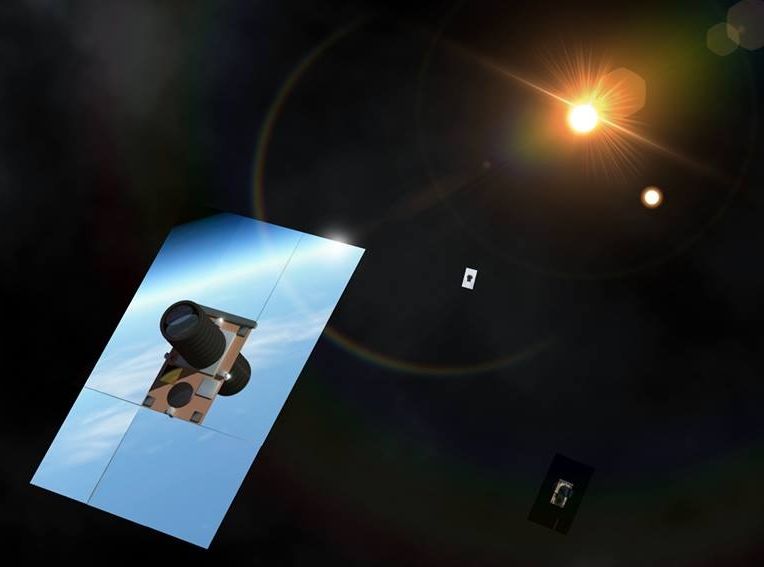Sure.
Category: space – Page 1,005
Entrepreneurs are the next superpowers
Nextbigfuture interviewed Naveen Jain at the Singularity University Global Summit. Naveen K. Jain is a business executive, entrepreneur and the founder and former CEO of InfoSpace and a fonder of Moon Express, Viome, World Innovation Institute, Bluedot, iNome, TalentWise and Intelius. He was Ernst and Young’s Entrepreneur of the Year, Silicon India’s “Most Admired Serial Entrepreneur,” and the receiver of “Albert Einstein Technology Medal” for his pioneers in technology, he has been repeatedly honored for his entrepreneurial successes. Red Herring also recognized him as one of the “Top 20 Serial Entrepreneurs” and with the “Lifetime Achievement Award.” In 2015, Naveen Jain had a net worth of $2.2 billion.

The Andromeda Study: A Femto-Spacecraft Mission to Alpha Centauri — Draft report finally published!!!
“This paper discusses the physics, engineering and mission architecture relating to a gram-sized interstellar probe propelled by a laser beam. The objectives are to design a fly-by mission to Alpha Centauri with a total mission duration of 50 years travelling at a cruise speed of 0.1c. Furthermore, optical data from the target star system is to be obtained and sent back to the Solar system. The main challenges of such a mission are presented and possible solutions proposed. The results show that by extrapolating from currently existing technology, such a mission would be feasible. The total mass of the proposed spacecraft is 23g and the space-based laser infrastructure has a beam power output of 15GW. Rurther exploration of the laser — spacecraft tradespace and associated technologies are necessary.”
NASA ‘Cribs’: Tour an Astronaut Habitat for Mock Space Missions (Video)
Ever wonder how astronauts will live on other worlds? Welcome to the Human Exploration Research Analog, or HERA, a habitat at NASA’s Johnson Space Center in Houston built to simulate the isolation of missions to deep space. You can take a tour of the HERA habitat with NASA interns in this new video in the style of the MTV series “Cribs.”
“HERA is a unique three-story habitat designed to serve as an analog for isolation, confinement, and remote conditions in exploration scenarios,” NASA officials explained in a video description. “This video gives a tour of where crew members live, work, sleep, and eat during the analog missions.”
The billionaire space race
How the tech billionaires are planning to send you into space.
John Thornhill investigates whether big government or big business will fund the future of space exploration.
Watch the full interview with ex-NASA Admin Charles Bolden:
Watch the full interview with sci-fi author Kim Stanley Robinson:
► Subscribe to FT.com here: http://bit.ly/2r8RJzM
► Subscribe to the Financial Times on YouTube: http://bit.ly/FTimeSubs



Chinese quantum satellite sends ‘unbreakable’ code
BEIJING (Reuters) — China has sent an “unbreakable” code from a satellite to the Earth, marking the first time space-to-ground quantum key distribution technology has been realized, state media said on Thursday.
China launched the world’s first quantum satellite last August, to help establish “hack proof” communications, a development the Pentagon has called a “notable advance”.
The official Xinhua news agency said the latest experiment was published in the journal Nature on Thursday, where reviewers called it a “milestone”.
The First Ever Blueprint for a Large Scale Quantum Computer has been Unveiled
An international team, led by a scientist from the University of Sussex, have today unveiled the first practical blueprint for how to build a quantum computer, the most powerful computer on Earth.
This huge leap forward towards creating a universal quantum computer is published today (1 February 2017) in the influential journal Science Advances. It has long been known that such a computer would revolutionise industry, science and commerce on a similar scale as the invention of ordinary computers. But this new work features the actual industrial blueprint to construct such a large-scale machine, more powerful in solving certain problems than any computer ever constructed before.
Once built, the computer’s capabilities mean it would have the potential to answer many questions in science; create new, lifesaving medicines; solve the most mind-boggling scientific problems; unravel the yet unknown mysteries of the furthest reaches of deepest space; and solve some problems that an ordinary computer would take billions of years to compute.